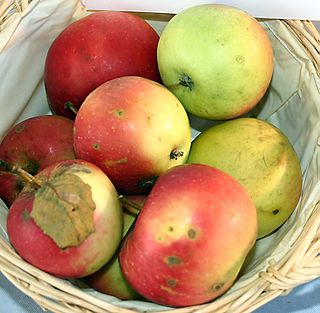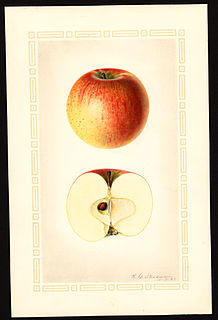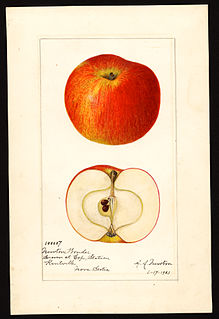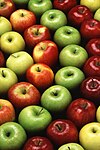
The cashew tree is a tropical evergreen tree that produces the cashew seed and the cashew apple pseudofruit. The tree can grow as high as 14 m (46 ft), but the dwarf cultivars, growing up to 6 m (20 ft), prove more profitable, with earlier maturity and greater yields.

Malus is a genus of about 30–55 species of small deciduous trees or shrubs in the family Rosaceae, including the domesticated orchard apple – also known as the eating apple, cooking apple, or culinary apple. The other species are commonly known as crabapples, crab apples, crabtrees, or wild apples.

Pollination of fruit trees is required to produce seeds with surrounding fruit. It is the process of moving pollen from the anther to the stigma, either in the same flower or in another flower. Some tree species, including many fruit trees, do not produce fruit from self-pollination, so pollinizer trees are planted in orchards.
Cider apples are a group of apple cultivars grown for their use in the production of cider. Cider apples are distinguished from "cookers" and "eaters", or dessert apples, by their bitterness or dryness of flavour, qualities which make the fruit unpalatable but can be useful in cidermaking. Some apples are considered to occupy more than one category.

The Miridae are a large and diverse insect family at one time known by the taxonomic synonym Capsidae. Species in the family may be referred to as capsid bugs or "mirid bugs". Common names include plant bugs, leaf bugs, and grass bugs. It is the largest family of true bugs belonging to the suborder Heteroptera; it includes over 10,000 known species, and new ones are being described constantly. Most widely known mirids are species that are notorious agricultural pests that pierce plant tissues, feed on the sap, and sometimes transmit viral plant diseases. Some species however, are predatory.

Gravenstein is a triploid apple cultivar that originated in the 17th century or earlier. The fruit has a tart flavor; in the Northern Hemisphere it is picked in July and August and is heavily used as a cooking apple, especially for apple sauce and apple cider. It does not keep well, and it is available only in season.

The Baldwin apple is a bright red winter apple, very good in quality, and easily shipped. It was for many years the most popular apple in New England, New York, and for export from the United States of America. It has also been known as 'Calville Butter', 'Felch', 'Late Baldwin', 'Pecker', 'Red Baldwin's Pippin', 'Steele's Red Winter', and 'Woodpecker'.

Antonovka, Антоновка, or Antonówka is a group of late-fall or early-winter apple cultivars with a strong acid flavor that have been popular in Russia as well as in Poland and Belarus. The most popular Russian variety is Common Antonovka, from which other cultivars derive. It was developed by pioneer Russian naturalist and plant breeder Ivan V. Michurin at his experimental orchard in the Tambov Oblast and introduced in 1888. Antonovka is famous for its unsurpassed strong and pleasant fruit aroma.

The 'Roxbury Russet' is an apple cultivar, believed to be the oldest apple cultivar bred in the United States, having first been discovered and named in the mid-17th century in the former Town of Roxbury, part of the Massachusetts Bay Colony southwest of Boston. It is known by several other names including 'Boston Russet', 'Putnam Russet', and 'Sylvan Russet'.

Spondias mombin, also known as yellow mombin or hog plum is a species of tree and flowering plant in the family Anacardiaceae. It is native to the tropical Americas, including the West Indies. The tree was introduced by the Portuguese in South Asia in the beginning of the 17th century. It has been naturalized in parts of Africa, India, Nepal, Bangladesh, Sri Lanka, The Bahamas, Indonesia, and other Caribbean islands. It is rarely cultivated except in parts of the Brazilian Northeast.

The Jonathan apple is a medium-sized sweet apple, with a touch of acid and a tough but smooth skin. It is closely related to the Esopus Spitzenburg apple, good for eating fresh and for cooking.
AppleTree Markets was a supermarket chain in Texas formed in 1969 when Safeway opened its first stores in Houston, which were spun off under the AppleTree name in 1988. The division once had 100 stores in Greater Houston and Greater Austin. By January 21, 2002, AppleTree had reduced its holdings to two stores in Bryan, Texas, where it had shifted its headquarters. One of the remaining locations was sold in 2009 and the final location, in Bryan at Highway 21 and Texas Avenue, closed in early 2012, marking the end of the chain.

Blenheim Orange is a cultivar of apple. It was found at Woodstock, Oxfordshire near Blenheim in England in about 1740. It has been described as a cooking apple.

Esopus Spitzenburg or Aesopus Spitzenburgh is a variety of apple. It was discovered early in the 18th century near Esopus, New York and is reputed to have been a favorite apple of Thomas Jefferson, who planted several of the trees at Monticello.
Polyphenol oxidase, an enzyme involved in fruit browning, is a tetramer that contains four atoms of copper per molecule.

The origins of the Rambo apple cultivar are unknown. It may date back to the American colony of New Sweden, when in 1637 Peter Gunnarsson Rambo, a Swedish immigrant, arrived on the Kalmar Nyckel. Swedish natural historian Pehr Kalm, who wrote Travels in North America, 1747–51, took notes of his interview with Mr. Peter Rambo, grandson of Peter Gunnarsson Rambo, recording that the ″original Peter Rambo had brought apple seeds and several other tree and garden seeds with him in a box.″ The first Rambo apple tree was very likely grown from one of these seeds. There is no certainty, however, since the earliest documented mention of the apple variety's origin occurs in William Coxe's A View of the Cultivation of Fruit Trees, and the Management of Orchards and Cider, published in 1817. Coxe wrote only that the Rambo was much cultivated in Delaware, Pennsylvania, and New Jersey and took "its name from the families by whom it was introduced into notice."

An apple is an edible fruit produced by an apple tree. Apple trees are cultivated worldwide and are the most widely grown species in the genus Malus. The tree originated in Central Asia, where its wild ancestor, Malus sieversii, is still found today. Apples have been grown for thousands of years in Asia and Europe and were brought to North America by European colonists. Apples have religious and mythological significance in many cultures, including Norse, Greek, and European Christian tradition.

Malus domestica Newton Wonder is a cultivar of apple which is usually eaten cooked due to its sourness. The variety has a similar but slightly sweeter taste than the Bramley apple and is usually used in pies or as a preserve.

'Creston' is an apple cultivar released by the Pacific Agri-Food Research Centre at Summerland, British Columbia.

















